SF Oddities: The Dutch Windmill
Since I moved to San Francisco over three years ago, I’ve always had a deep and genuine love for Golden Gate Park. From the first few weeks at USF as a freshman in 2004, I have always made it a point to enjoy the pleasantries the park has to offer-sun tanning and frisbee on the conservatory lawn, long-board cruises to Ocean Beach, the drum circle at hippie hill, a walk along Stow Lake-the list goes on and on.
I often made my way through the park, usually on skateboard, and would eventually wind up at Ocean Beach. I have always wondered about the huge windmill that sits about 100 yards from the beach, but never bothered to follow my curiosity until now.
I once heard a story that the windmill was a gift from the Dutch and was either shipped or assembled here around the early 1900’s. I heard another story that the windmill is now the site of some kind of anonymous male homosexual activity.
Many others seem to have heard rumors as well. I went to the library and first spoke with Elyse, a student staff member who recently moved to San Francisco from Seattle. Since arriving here, she has not seen nor heard anything about the dutch windmill.
Another staff member (not a student, but she wanted to remain anonymous) has been living in SF for 9 years, and first visited the windmill soon after arriving in the city. She remembered hearing a rumor having something to do with Queen Elizabeth, and thought that there was some connection to the tulip garden that is located just southeast of the windmill.
After doing a bit of research, I found that there is an amazing history behind the windmill. What I found is quite different than the rumors that are circulating around town.
First of all, the windmill has nothing to do whatsoever with the Dutch except that its design is resemblant of a Dutch windmill. The structure was not a gift from the Dutch; rather, it was erected in 1902 as a solution to the lack of fresh water irrigation in the just-forming Golden Gate Park. At the time, the park and surrounding areas were nothing more than an endless series of sand dunes, hardly making the area ideal for vegetation.
However John McLaren, the superintendent of the park at the time, decided that the land needed to be developed and pushed forward with the project by ordering the drilling of wells near the coast to tap the fresh water source believed to be nearby. After much initial skepticism regarding the extent of the fresh water source and the amount of power the windmill would provide for irrigation, the windmill was finally completed around June 1902 at the cost of $20,000. Below is an original blueprint I found online.
The original irrigation plan was this: strong ocean winds powered the sails, which were connected to a pump. The pump ran into the seaside wells and pressure within them forced water out at thousands of gallons per hour. The water then traveled into a main which ran through the park. The water main emptied into reservoirs at Strawberry Hill and Spreckles Lake, and these were the main arteries that were used to irrigate the entire park. Below is a link to a map showing the location of the Dutch and Murphy (see Murphy windmill info later) windmills, and the reservoirs they emptied into in relation to the entire park.
At the time, this method of irrigation was highly effective. The first windmill was so effective that a second windmill was built just south of the Dutch windmill, the Murphy windmill, named after Sam Murphy, a banker who invested $20,000 in the project. This second windmill was even larger than the first, making it at the time the largest windmill of its kind in the world.
By 1905, the two windmills were providing enough water to irrigate over 2 million trees that had been introduced to the park.
There was one man, one magical man that I would love to find, that lived in a cottage adjacent to the windmill and was available for ’round the clock repairs. During storms, he would manually have to apply emergency brakes to the windmills’ sails to keep them from spinning out of control and eventually ripping off. Could you even imagine….
Then, it all came to a screeching halt, in one simple, yet bright word…
…Electricity…it has a certain buzz doesn’t it?
In 1913, electric pumps replaced the windmill-driven pumps in the wells in order to circulate water at a much faster rate. The windmills, only 10-12 years old, became immediately obsolete. They were abandoned, and soon succumbed to vandalism. In the early 1930’s, a huge storm destroyed much of the windmill’s interior. During World War 2, many of the windmill’s parts were gutted fr use in the war effort. And to put the icing on the cake, one of the sails was ripped off during a 1949 storm; the other two were soon removed by the city because they presented a safety hazard.
50 years went by and nothing happened. The windmills were neglected and abused. All of the sails and the observation deck on Murphy’s windmill eventually fell off, and today only the base remains. Below is Murphy’s windmill in original form, and then how it looks today.
These amazing structures would prevail however, mostly due to the efforts of individual citizens such as Eleanor Rossi Crabtree, daughter of former SF mayor Angelo Rossi (1931-1943). Her efforts, along with the help of the John McLaren society and the Centennial Windmill Restoration Society, helped secure a $10,000 federal grant for the restoration of the windmills. Red tape kept the process from beginning until 1976, but it was successfully completed by a U.S. Navy unit stationed out of Treasure Island in 1981.
Currently the windmill’s seem to be fairly unnoticed, despite the fact that they seem quite odd compared to the architecture of the rest of San Francisco. One possibile reason for this is that the canopy of the park conceals the view of the windmill, even from just around the bend.
Even from the Safeway parking lot across the street.
Even standing about 50 feet directly in front of the windmill, the heavy shrubbery and thick tree canopy overshadow the much taller windmill.
If you are anywhere near USF, the windmill is not visible at all. I have a pretty decent view near my apartment, which sits on top of a huge hill around where Anza st. hits a cliff directly above Ocean Beach.
I couldn’t find any information online (which doesn’t surprise me much), but I’ve heard several rumors about the area around the windmill being some sort of hub for male homosexual activity. While spending time at the windmill I didn’t see anything that looked out of the ordinary, nor have I met anyone that has actually seen any activity of the sort, so I can’t confirm or deny the rumors.
If you haven’t seen the dutch windmill in person, I highly recommend packing a lunch and taking a trip through the park, working your way down the paths along JFK Dr. until you hit the windmill, which is situated at the very edge of the park nearest the ocean, between Fulton and JFK.
On a clear day, it doesn’t matter what time of day you make the trip. As you have seen, the views are amazing during peak hours of the day. The sunset is amazing as well. Even if you miss it, the minutes after dusk offer great views as well. If you walk along JFK Dr. to the corner where the park ends, you can look left and view the sunset, then look right and view the windmill in the dwindling light.
Just a little further to the east (towards the middle of the park) you will find the Queen Wilhelmina tulip garden.
The garden was given its’ name in 1962 after the death of the Netherlands’ ruler of 58 years. It fitting overlooks the dutch windmill, and offers some stunning views, along with benches that offer a nice place to sit, relax, and enjoy that lunch you packed.
There is currently an effort to continue the restoration of the windmills, and to turn the area into a community recreation space. For more information and to learn how you can help, visit the Campaign to Save the Golden Gate Windmills.
Click here for the extended Flickr set with many more pictures AND…
…Below is a slideshow of some pictures I took from various angles near and around the windmill.

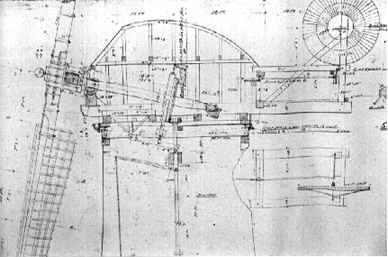
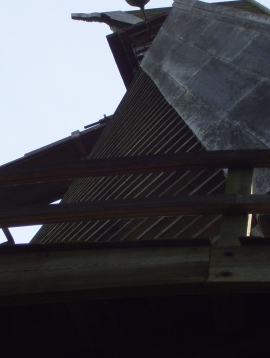

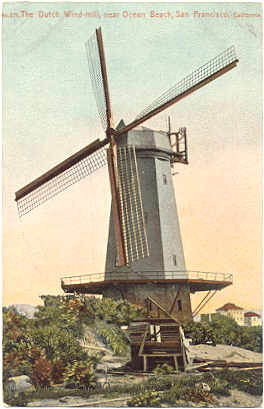
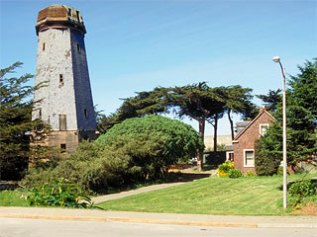
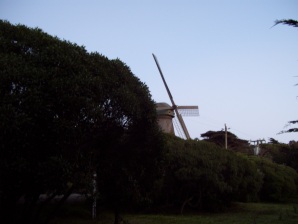
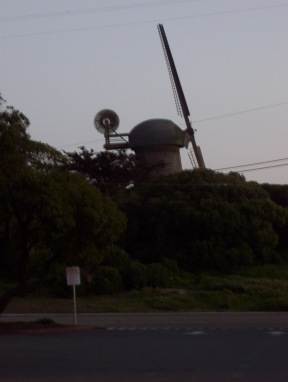
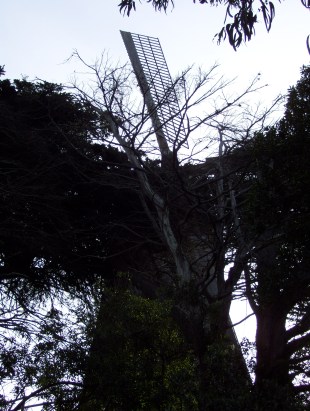
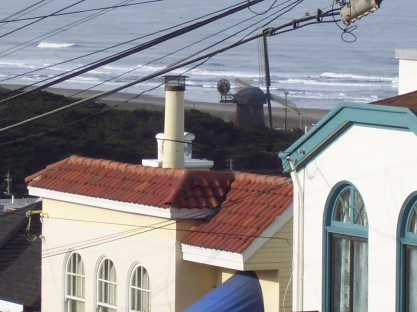
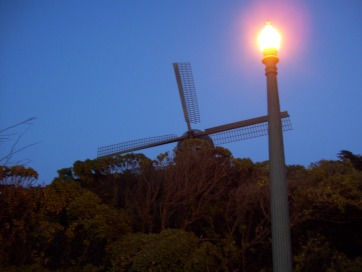
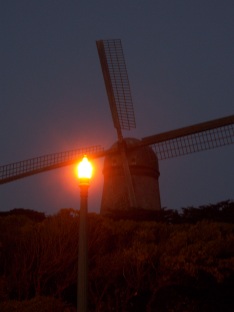
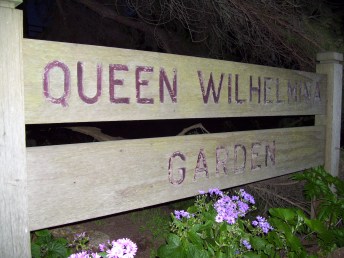


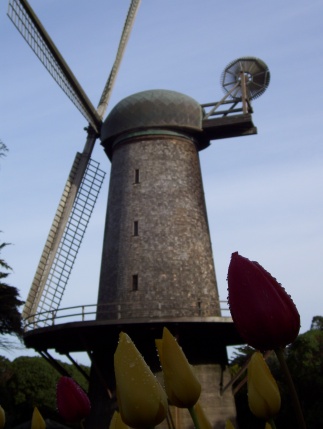

April 28, 2008 at 7:19 pm
[…] A few years after the world-renowned fair, the beautiful structures were abandoned; once America entered the Depression and WWII, they succumbed to neglect, abuse, and they served as military posts among other odd things-much different than what was their original intention (i.e. Dutch Windmill). […]